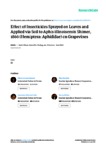Please use this identifier to cite or link to this item:
http://www.alice.cnptia.embrapa.br/alice/handle/doc/1047672| Title: | Effect of insecticides sprayed on leaves and applied via soil to Aphis illinoisensis Shimer, 1866 (Hemiptera: Aphididae) on grapevines. |
| Authors: | BARONIO, C. A.  NONDILLO, A.   CUNHA, U. S. da   BOTTON, M.   |
| Affiliation: | Cléber Antonio Baronio, Departamento de Fitossanidade - Universidade Federal de Pelotas, Caixa Postal 354, CEP: 96010-900, Pelotas, Rio Grande do Sul, Brazil; Aline Nondillo, Laboratório de Entomologia, Embrapa Uva e Vinho, Caixa Postal 130, CEP: 95700-000, Bento Gonçalves, Rio Grande do Sul, Brazil; Uemerson Silva da Cunha, Departamento de Fitossanidade - Universidade Federal de Pelotas, Caixa Postal 354, CEP: 96010-900, Pelotas, Rio Grande do Sul, Brazil; MARCOS BOTTON, CNPUV. |
| Date Issued: | 2016 |
| Citation: | South African Journal for Enology and Viticulture, v. 37, n. 1, p. 61-66, 2016. |
| Description: | High infestations by the grapevine aphid Aphis illinoisensis (Hemiptera: Aphididae) have been observed in vineyards in southern Brazil, retarding plant growth and causing premature berry drop. This study evaluated the effect of insecticides on the control of the species in two experiments carried out in a greenhouse. The first control experiment for A. illinoisensis was conducted with seedlings of Vitis vinifera var. ‘Cabernet Franc’ to assess the effect of azadirachtin (Azamax®) at dosages of 2.4 and 3.6 mL a.i. (active ingredient)/100 L of water, with reapplication seven days after the first application (DAFA). To compare its effect, the neonicotinoids imidacloprid (Provado 200 SC®) and thiamethoxam (Actara 250 WG®) were sprayed at dosages of 8 mL or g a.i./100 L of water in foliar application without reapplication. The second experiment compared the effect on A. illinoisensis by spraying these neonicotinoids at dosages of 8 mL or g a.i./100 L in foliar applications and of 0.05 mL or g a.i./100 L applied in the soil. Evaluations were performed at 0, 1, 5, 7, 10 and 14 DAFA. Imidacloprid and thiamethoxam effectively controlled A. illinoisensis in both forms of application [soil and foliar], while azadirachtin at the dosage of 3.6 ml a.i./100 L reapplied seven days after the first application provided 55.7% control. In conclusion, A. illinoisensis can be controlled effectively by employing neonicotinoids in the soil, while azadirachtin can be an alternative to reduce infestation pressure. Key words: Grapevine aphid, chemical control, pest management, azadirachtin |
| Thesagro: | Uva Doença de planta Controle Químico Pulgão |
| NAL Thesaurus: | Chemical control Pest management Azadirachtin |
| Keywords: | Manejo de pragas Azadiractina Pulgão das videiras Pragas Videira Grapevines aphid |
| Type of Material: | Artigo de periódico |
| Access: | openAccess |
| Appears in Collections: | Outras publicações (CNPUV)  |
Files in This Item:
| File | Description | Size | Format | |
|---|---|---|---|---|
| 2016BARONIOEffectsofinsecticidessprayed1.pdf | 557,78 kB | Adobe PDF |  View/Open |









